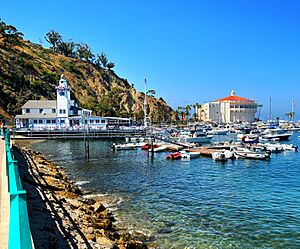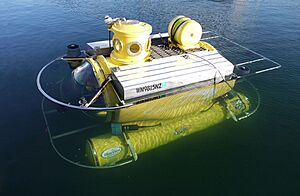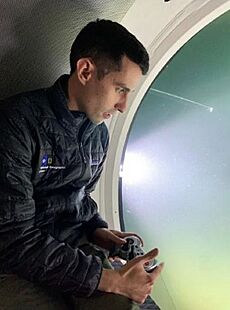OceanGate facts for kids
 |
|
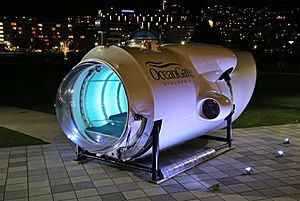
Cyclops 1 submersible on display at Seattle's Museum of History & Industry (MOHAI)
|
|
| Private | |
| Industry | Tourism, expeditions, underwater diving |
| Founded | 2009 |
| Founders | Stockton Rush
|
| Headquarters | Everett, Washington, U.S. |
|
Key people
|
|
OceanGate Inc. was an American company based in Everett, Washington. It offered trips in special underwater vehicles called submersibles. These trips were for tourism, research, and exploring the ocean. The company was started in 2009 by Stockton Rush and Guillermo Söhnlein.
OceanGate bought one submersible called Antipodes. Later, they built two more: Cyclops 1 and Titan. In 2021, OceanGate started taking people on trips in Titan to see the wreck of the Titanic. A ticket for this trip cost $250,000 per person in 2022.
On June 18, 2023, the Titan submersible was lost during a trip to the Titanic. All five people on board, including Stockton Rush, died. A large search and rescue effort began. On June 22, parts of the Titan were found on the seabed. They were about 500 meters (1,600 ft) from the Titanic wreck. OceanGate's office in Everett closed, and by July 6, 2023, the company stopped all its operations. Gordon Gardiner became the CEO in August 2023 to help close the company. OceanGate has now permanently stopped all business.
Contents
About OceanGate's Journey
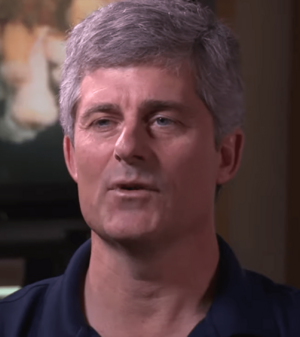
How OceanGate Started
Stockton Rush loved aviation and space travel when he was young. He got a pilot's license at 18. Later, he became very interested in exploring under the sea. Rush used money he inherited to invest in technology companies. He wanted to buy a submarine but found it was very hard. So, in 2006, he built his own submersible from plans. He named it Suds.
Rush believed that exploring the ocean was not done enough. He thought submersibles were safer than people believed. He once said that submersibles were "the safest vehicles on the planet." He also had a study done that showed many people wanted to go on underwater tours.
Early Years and Antipodes
OceanGate was started by Guillermo Söhnlein and Stockton Rush in Seattle in 2009. Their goal was to create a small group of 5-person submersibles. These could be rented by different groups or people. Söhnlein said their early motto was "Open the oceans for all of humanity."
The company's first submersible was Antipodes. It was a used 5-person vessel with a strong steel body. Between 2010 and 2013, OceanGate made about 130 dives with Antipodes. The company rented out its submersible to researchers. They also took tourists, who they called "citizen scientists," on underwater trips. In 2012, passengers usually paid between $7,500 and $40,000 for a trip.
OceanGate's first tourist trip was in 2010. They took groups to Catalina Island in California. To make trips better, they started bringing expert guides. These guides, like marine biologists, could answer questions about sea life. Rush said, "Their excitement permeated the sub."
In 2010, OceanGate worked with the University of Washington. The university used Antipodes to test new sonar and robotic arms. The next year, Antipodes explored the wreck of the SS Governor. This ship sank in Puget Sound in 1921.
In 2012 and 2013, OceanGate worked in Miami, Florida. They helped researchers study the spread of lionfish.
Building Cyclops 1 and Titan
In 2013, OceanGate started designing its own submersibles. They wanted unique designs that were also affordable. Guillermo Söhnlein left the company that year. He said OceanGate was moving into Stockton Rush's area of engineering. Söhnlein still owned a small part of the company.
OceanGate worked on its first custom-built submersible, Cyclops. It was later named Cyclops 1. They worked with the University of Washington and Boeing. The original plan was to use a carbon fiber body. But instead, OceanGate used a steel body from an older vessel called Lula. Cyclops 1 was shown in 2015. That same year, the company moved its main office to Everett, Washington.
OceanGate ordered parts for Cyclops 2 in December 2016. In March 2018, Cyclops 2 was renamed Titan. Rush called it "an amazing engineering feat." Titan was tested to its deepest planned depth of 4,000 m (13,000 ft) in 2018 and 2019.
In 2019, OceanGate planned to build Cyclops 3 and Cyclops 4. These were meant to go as deep as 6,000 m (20,000 ft). In early 2020, they announced that NASA's Marshall Space Flight Center would help build the bodies. NASA said they did not do the actual testing or building themselves.
During the COVID-19 pandemic in spring 2020, OceanGate received a loan of about $450,000. This loan was to help keep 22 jobs.
In 2021 and 2022, OceanGate took trips to the Titanic using its Titan submersible.
Titan Incident and Company Closure
The Titan submersible was lost during a trip to the Titanic in June 2023. All five people on board, including CEO Stockton Rush, died. An international search team, including the United States Coast Guard and U.S. Navy, searched for four days. On June 22, parts of the Titan were found. They were about 500 metres (1,600 ft) from the front of the Titanic. This showed that the submersible had broken apart suddenly due to pressure.
After the news about Titan, OceanGate closed its Everett office. Soon after, its related company, OceanGate Expeditions, also stopped operations. In July 2023, OceanGate's websites showed a message: "OceanGate has suspended all exploration and commercial operations."
OceanGate's Submersibles
OceanGate owned three submersibles. The Cyclops 1 and Titan submersibles used a special "Launch and Recovery Platform." This platform could be pulled by a ship. When they reached the dive spot, the platform would fill with water and sink about 9 m (30 ft) deep. The submersible would then leave the platform for its mission. When the submersible returned, the platform would pump out the water and float up. This system allowed OceanGate to use regular ships without special cranes. The platform was about 35 ft (11 m) long and 15 ft (4.6 m) wide. It could lift up to 20,000 lb (9,100 kg).
The Antipodes Submersible
Antipodes is a submersible with a steel body. It can go down to 300 meters (1,000 ft) deep. OceanGate bought it in 2010. In 2010, OceanGate took its first paying customers in Antipodes near Catalina Island in California. The submersible was also used for trips to study corals, lionfish in Florida, and an old oil rig in the Gulf of Mexico. By 2013, OceanGate had made over 130 dives with Antipodes.
The Cyclops 1 Submersible
In March 2015, OceanGate showed off Cyclops 1. It was a 5-person submersible with a steel body. It could dive up to 500 meters (1,640 ft) underwater. It was about 6.7 m (22 feet) long and 2.7 m (9 feet) wide. It weighed about 9,100 kg (20,000 pounds). Its name came from its strong, clear window. The submersible was controlled by a changed wireless game controller. Its battery could last up to eight hours. Cyclops 1 was used for many business and science trips.
OceanGate built Cyclops 1 with the University of Washington's Applied Physics Laboratory. Boeing also helped with the first design ideas. The original plan was for a carbon fiber body, but they used a steel body instead. OceanGate got the steel body for Cyclops 1 in 2013. It had been used for 12 years. OceanGate then put in a new inside, underwater sensors, and the gamepad control system.
In June 2016, Cyclops 1 explored the wreck of SS Andrea Doria. This wreck was 73 m (240 feet) below the surface. The information gathered helped create a computer model of the wreck. In 2019, the submersible took researchers to the bottom of Puget Sound to study marine life.
The Titan Submersible
Titan was the second submersible designed and built by OceanGate. It was known as Cyclops 2 until 2018. It was the first privately owned submersible meant to go as deep as 4,000 m (13,000 ft). Its main window was only rated for 650 m (2,130 ft). An engineer warned that the design might fail after only a few deep dives. It was also the first crewed submersible to use a body made of titanium and carbon fiber. Most other submersibles that carry people use all-metal bodies.
Titan was first designed with the University of Washington and Boeing. Both groups gave many design ideas and strict testing rules. Stockton Rush did not follow these rules. The partnerships ended because Rush did not want to work within quality standards. A new body was built in 2021 because the first one cracked after 50 dives. Only three of those dives reached 4,000 m (13,000 ft). The new submersible reused parts from the old one. It also added lifting rings, even though engineers advised against it. They said the Titan could not handle extra weight or pulling.
On June 18, 2023, OceanGate lost contact with Titan during its dive to the Titanic. Losing contact had happened before on test and tour dives. So, OceanGate did not tell authorities right away. A huge international search and rescue effort began. It ended on June 22, 2023. Parts of Titan were found about 500 meters (1,600 ft) in front of the Titanic. This showed that the submersible had broken apart suddenly, killing all five people inside.
OceanGate's Related Groups
When Titan was lost, OceanGate had three related groups. Its main office was in Everett, Washington. There was also a company in the Bahamas called Argus Expeditions Ltd, which operated as OceanGate Expeditions. Finally, there was a separate non-profit group called the OceanGate Foundation. This foundation gave money to scientists who joined missions. Stockton Rush was listed as the treasurer of the non-profit. His wife, Wendy Rush, was listed as the director and president.
See also
 In Spanish: OceanGate para niños
In Spanish: OceanGate para niños
- Extreme tourism
- List of submarine and submersible incidents since 2000


